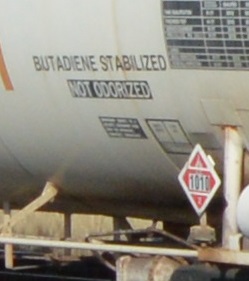 |
| Hazmat Training |
I had gone to town to take a picture of the depot, so a mixed freight coming through on the close track at probably 60 mph caught me by surprise. The pictures are not good, but the numbers are big and even when speed-blurred, can be read. A DOT guidebook allows me to interpret the numbers: (Update: I'm adding other tank cars that I have found since then.)
- 1267: 128 Petroleum crude oil
- 2227: 130P n-Butyl methacrylate, stabilized
- 1760: 154 Ferrous chloride, solution
- 1280: 129 Propyl chloride
- 1993: 131 Compound, cleaning liquid (flammable)
- 1017 124 Chlorine
- 1832 137 Sulfuric acid, spent
- 3463 132 Propionic acid, with not less than 90% acid
- 1086: a, b, c 116P Vinyl chloride, stabilized
- 1301 129P Vinyl acetate, stabilized
- 1063 115 Methyl chloride
I analyzed another mixed freight. I shot pictures of five cars at the time because I was interested in the type of car, not the signs on the car when I took the pictures. So the resolution is not good enough to read the numbers. But two of the tank cars had blue cards and one was Type 9.
 |
| 20150427 9469c |
- 1075: 115 Butane, ten of them in two cuts
- 1267: Crude oil, it is strange to see just one of these in a train
- 3257: 131 Nitriles, poisonous, flammable, n.o.s., two of them (Facebook)
I include a closeup of one of the 1075 cars. Evidently Butane is also Liquefied Petroleum Gas. I find it disturbing that it is non-odorized. That probably means if a tank setting on a siding springs a leak, it will be hard to detect until a fire or explosion happens.
3257 is nasty enough that they include an 800 number on the car to call in case of emergency.
 |
| 20141211 0077c |
- 2448: 133 Sulfur, molten, five of them
- 3082: 171 Environmentally hazardous substances, liquid, n.o.s., nine of them
Update: I passed a Sherman-Williams semi-truck trailer on I-57 hat had both flammable and corrosive placards.
 |
| 20171017 6323 |
- 1010: Butadienes, stabilized 116P
- 1010: Butadienes and hydrocarbon
mixture, stabilized
116P
- 1017 Chlorine
- 1136 Coal tar distillates, flammable (again)
- 1202 Diesel fuel; fuel oil; gas oil; heating oil, light (again)
- 1295 Trichlorosilane Alan Roeben: "Gives off hydrochloric acid when it gets in contact with water. Used in silicon conductors when ultrapure."
- 1832 Sulfuric acid, spent
- 1993 Combustible liquid, n.o.s.; Compounds, cleaning liquid (flammable); Compounds, tree or weed killing, liquid (flammable); Diesel fuel; Flammable liquid, n.o.s.; Fuel oil
- 2428 Sodium chlorate, aqueous solution (again)
- 3257: 131 Nitriles, poisonous, flammable, n.o.s
- 3475 Ethanol and gasoline mixture, with more than 10% ethanol (again)
Railfanning:
- 1203 128 Gasohol, Gasoline, Motor spirit, Petrol
ERG 2106 (Emergency Response Guide 2016) is now available for download. I learned of this link from a Facebook posting to a closed group by Jimmie Fisher. He says the guide is issued every four years. The 2012 version I had was 4,250kb, this version is 4,780kb. I'm glad I noticed this link because I have discovered that the 2012 link I had at the beginning of this posting was a temporary link and is now broken. I have updated that URL to this URL. Hopefully this URL is more permanent.
 |
Jimmie Fisher posted Bristol, Virginia, November 28, 2009, 11:52am. ETCX 84001: Tank car, 4 compartments, owned by Eastman Chemical Company. Compartment 1: Capacity 5,724 gallons, methyl isobutyl ketone, hazmat placard number 1245. Compartment 2: Capacity 5,734 gallons, methyl isobutyl ketone, hazmat placard number 1245. Compartment 3: Capacity 5,734 gallons, unspecified flammable liquid, hazmat placard number 1993. Compartment 4: Capacity 5,729 gallons, unspecified flammable liquid, hazmat placard number 1993. Light weight: 87,500 pounds. Load limit: 175,500 pounds. Coupled length: 61 feet 1 inch. Built March, 1997, builder unknown. John W. Coke 1993 (Diesel n.o.s.)Flammable Liquid Jimmie Fisher Hazmat placard 1993 refers to several different combustible/flammable liquids, including, but not limited to, diesel fuel, fuel oil, herbicides, and cleaning fluids. Reference ERG (Emergency Response Guide) 2016. |
The new URL is more permanent, but it is harder to find the .pdf. I finally found the 2020 version.
March 31, 2021 in Downers Grove, IL
New codes:
- 2031: 157 Nitric acid, other than red fuming, with not more than 65% nitric acid
- 1987: 127 Alcohols, n.o.s.
- 3295: 128 Hydrocarbons, liquid, n.o.s.
Codes that have already been documented in these notes:
- 1760: 154 Ferrous chloride, solution
- 1993: 131 Compound, cleaning liquid (flammable)
- 3257: 131 Nitriles, poisonous, flammable, n.o.s. It is labeled HOT ASPHALT.
- 1075: 115 Butane












No comments:
Post a Comment